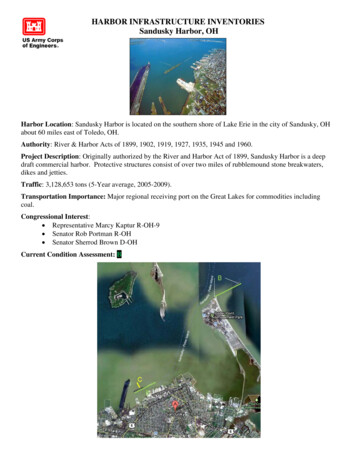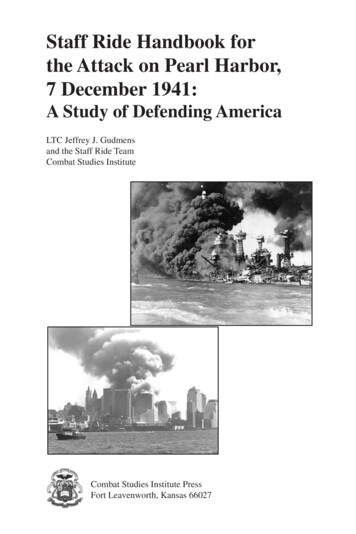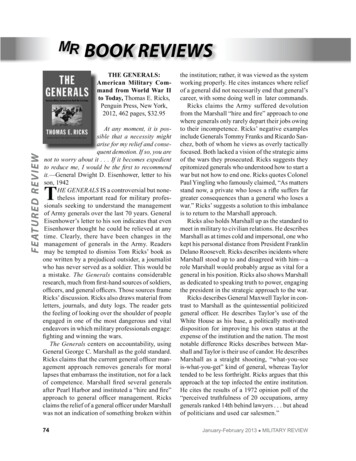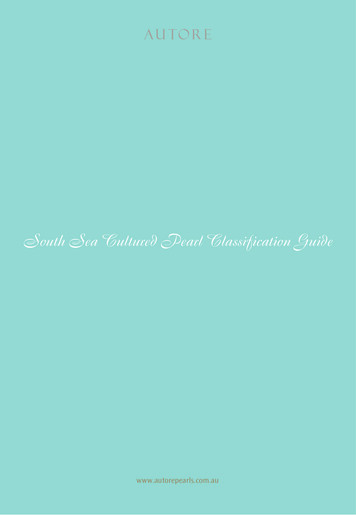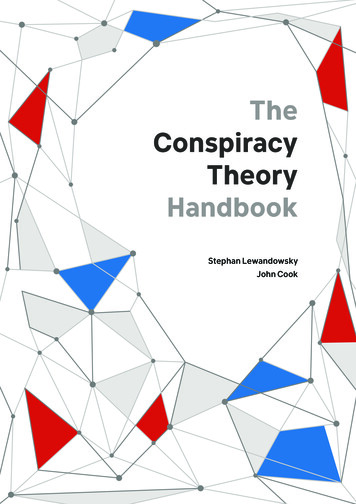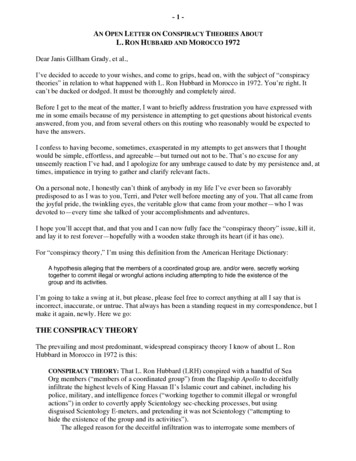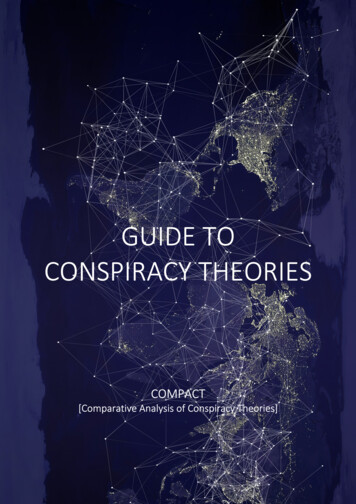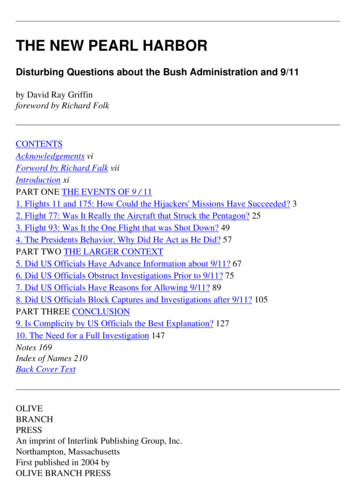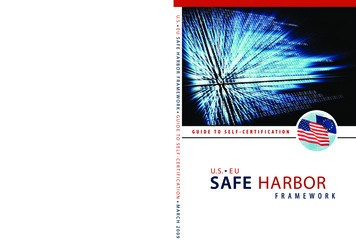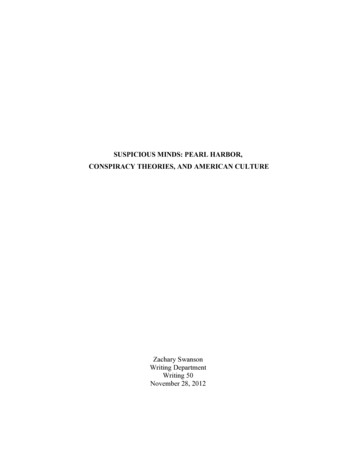
Transcription
SUSPICIOUS MINDS: PEARL HARBOR,CONSPIRACY THEORIES, AND AMERICAN CULTUREZachary SwansonWriting DepartmentWriting 50November 28, 2012
SUSPICIOUS MINDS: PEARL HARBOR,CONSPIRACY THEORIES, AND AMERICAN CULTUREThe Pearl Harbor Conspiracy TheoriesOn the morning of December 7, 1941, the Japanese attacked the United States naval baseat Pearl Harbor, killing 2,402 Americans, sending a shockwave across the surprised nation,collapsing the isolationist movement overnight, and leading the US into the most devastating warin history. The attack was one of the most monumental turning points in American history.President Franklin D. Roosevelt declared it “a date which will live in infamy.” The presidentcould not have been more accurate in his statement yet at the time could never realize its fullimplications: that Pearl Harbor would become infamous not solely for the tragedy of the attack,but for the cloud of conspiracy theories—with FDR himself at their core—that would surroundit. What gave rise to these theories? What made them so popular in the past and even today?To analyze the historical events and answer these questions, one must first understandthe details of the theories, along with the psychological and sociological basis of conspiracythinking in general. This research gives insight into the logic behind the formation of conspiracybeliefs and the appeal of sharing them: the conscious and sub-conscious benefits that conspiracythinking offers to the believer. Applying this knowledge to Pearl Harbor raises a number ofrevealing questions, and investigating them can teach us a lot about ourselves, our history, ourculture, and the way we view our own government. The formation and popularity of the PearlHarbor conspiracy theories was due to the nature of the attack and the strong feelings of chaosand powerlessness that followed in its wake, along with a general distrust of government that haslong been ingrained in American culture.Before delving into the psychology of conspiracy thinking or giving an analysis of thetheories’ appeal, it is useful to understand the details of the Pearl Harbor conspiracy theories1
Swanson: Suspicious Minds 2themselves, along with the main arguments and points of controversy. This contextualinformation only scratches the surface (the examples provided are much more complex than theyappear here) but it provides the necessary perspective to investigate the phenomenon ofconspiracy thinking. The first and most prevalent is the “prior-knowledge” theory that PresidentRoosevelt had foreknowledge of the Japanese plan to attack Pearl Harbor but kept it secret.According to the theory, he left the naval base unprepared in order to subvert the isolationistmovement and gain public favor for war so that he could justify US intervention in World WarII. A second conspiracy theory, often intertwined with the first, argues that in the years leadingup to Pearl Harbor, FDR had been working to provoke the Japanese or the Germans to attack.Ever since the massive death tolls of trench warfare in World War I, most Americans hadfavored an isolationist foreign policy, wanting to remain uninvolved in the affairs of Europe andthe rest of the world. This sentiment grew even stronger following the outbreak of World War II;Americans did not want to get involved in another brutal and costly war. FDR was certainlyaware of this, and in his 1940 campaign for re-election, he promised that he would not lead thecountry into war.1 However, few historians would argue against the notion that this promisebelied his true wishes: it is widely accepted that Roosevelt wanted to intervene in World War II.He had already started the process of re-armament of the Army and Navy and continued toprovide money, weapons, and supplies to the allies through the Lend-Lease Act.2 In a nowfamous fireside chat in December of 1940, FDR publicly argued for greater Americaninvolvement in the war, describing his wish for America to become the “Arsenal of1“United States Presidential Election of 1940,” ude to WW II: Isolationism, Refugee Policy and the Roosevelt research/americanhistory/ap ww2-prelude.php#prelude.
Swanson: Suspicious Minds 3Democracy.”3 The American populace, however, remained isolationist, and the president wasattacked and labeled as a “warmonger” by anti-war groups such as the America FirstCommittee.4 Proponents of the Pearl Harbor conspiracy theories argue that Roosevelt knew theonly way that he could gain favor for war would be if the US were struck first, which motivatedhim to provoke an attack, or to keep his knowledge of the Japanese attack plans secret.Believers in Pearl Harbor conspiracy theories cite a large volume and variety ofinformation as evidence of FDR’s foreknowledge: intercepted messages, radio transmissions,warnings by various parties, statements by US officials, and even random coincidences.Conspiracy theorists commonly make various claims relating to how far along the USintelligence was in cracking Japanese codes in the months preceding Pearl Harbor. The facts arethat the US was still unable to read the Imperial Japanese Navy’s code but had successfullycracked and was reading the highest security Japanese diplomatic code known as “Purple.”5Although this breakthrough would prove instrumental later in the war, these “Purple”transmissions carried very little relevant information about Japanese military plans until after thePearl Harbor attack.6 Perhaps the most famous piece of Pearl Harbor lore is known as the “bombplot” message, which was sent by Japanese Naval Intelligence to their consulate in Honolulu onSeptember 24, 1941 and decoded in Washington on October 9, almost two months before theattack.7 The message (Figure 1) requested the locations of all American vessels stationed in PearlHarbor based on a grid system but it was not shared with Rear Admiral Kimmel or MajorGeneral Short, the men in command at Pearl Harbor. For many believers this is “the smoking3“Franklin Delano Roosevelt: The Great Arsenal of hes/fdrarsenalofdemocracy.html.4“Prelude to WW II: Isolationism, Refugee Policy and the Roosevelt research/americanhistory/ap ww2-prelude.php#prelude.5“TimeLine of Purple in World War II,” /Welcome.htm.6“TimeLine of Purple in World War II,”7“Dorn Report Part Three: The Pearl Harbor Investigations,” last modified December 24th, 1996,http://www.ibiblio.org/pha/pha/dorn/dorn 3.html.
Swanson: Suspicious Minds 4gun” that proves FDR withheld prior knowledge of the Japanese attack plans. Opponents of thistheory argue that the implications of the message were simply not fully understood, for it madeno mention of a date or an attack, and so the information was not passed along. It is important torealize that these were simply a few pieces of information among thousands of decodedmessages and intelligence reports being analyzed by Navy and Army Intelligence. Furthermore,the sharing of information between the different branches of the military, and even the WhiteHouse, was very poor at the time as there was no central organization in charge of coordinatingthe various intelligence divisions until l942. Believers say the failure to pass along suchimportant information was an intentional act of conspiracy, while an official National SecurityAgency report states that it was an unintentional result of incompetence and misjudgment.Figure 1: The “Bomb Plot” Message.Source: William P Litynski, “Prior Knowledge? A HistoricalAnalysis of the ‘Surprise Mass Attack on Pearl Harbor’”
Swanson: Suspicious Minds 5Pro-conspiracy articles commonly cite early warnings of an attack on Pearl Harbor givenby a number of different nations and individuals only one of which can be verified. In January1941, the Peruvian ambassador to Japan reported to the US embassy that the Japanese wereconsidering a plan to attack Pearl Harbor in the event that relations with the US broke down.Naval intelligence did not consider the report credible since the source of the information wasthe ambassador’s Japanese cook, and it was quickly dismissed.8 Another facet of this proconspiracy argument is the fact that none of the US Pacific Fleet aircraft carriers were in PearlHarbor on the day of the attack. The proposed reasoning is that they were the most valuableships, and so they were intentionally ordered away to protect them from the attack. There areseveral flaws with this argument, the first of which is that one of the carriers was under orders toreturn to Pearl Harbor on December 6, the day before the attack but was slowed by bad weather.The second is that under US naval strategy at the time, battleships, not carriers, were consideredto be the most important assets of the fleet. 9 It was, in fact, the attack on Pearl Harbor thatdemonstrated the effectiveness of aircraft carriers and forever altered US naval strategy. Similarconjectures of conspiracy are made about the firing by FDR of Admiral James Richardson inFebruary 1941, for resisting orders to move the fleet to Pearl Harbor. The last major topic ofcontention is the claim that US ships detected radio traffic from the Japanese striking force as itheaded towards Hawaii. Surviving Japanese officers, however, have since reported that there wasno radio traffic to overhear because the radio transmitters in the ships and planes of the attackforce had been physically disabled to ensure radio silence.10 Believers argue that the8“The Pacific War Online Encyclopedia,” http://pwencycl.kgbudge.com/P/e/Pearl Harbor.htm.“United States Navy Aircraft Carriers December 07, 1941,” http://bluejacket.com/ww2 12-07-41 carriers.html.10Robert J. Hanyok, “Catching the Fox Unaware: Japanese Radio Denial and Deception and the Attack on PearlHarbor,” Naval War College Review (Autumn 2008): 108.9
Swanson: Suspicious Minds 6accumulation of these early warnings, the bomb plot message, and countless other fragments toonumerous to be detailed here made it clear to FDR that Pearl Harbor was at risk.The arguments and actions cited as proof of FDR’s attempts to provoke war are alsonumerous. Three of the central points include FDR’s decision to cut off oil to Japan, the de-factonaval war he had escalated with Germany, and a memo written by Lieutenant CommanderArthur McCollum. In July 1941, FDR cut off the export of US oil to Japan. Conspiracy theoristsargue that this was an attempt to starve Japan of oil, thus driving the nation to attack the US,which had previously supplied 80 percent of Japan’s oil.11 Opponents argue that cutting thesupply of oil, a crucial necessity for waging war, was simply the logical move given that the USopposed the Japanese invasion of China. Another of FDR’s pre-war policies, the “shoot on sight”order that US Navy ships were to fire on German ships and submarines, has also come underscrutiny as an attempt to provoke war. The order was given in response to the attack of the USSGreer by a German U-boat off the coast of Greenland in September 1941. FDR reported that“the German submarine fired first upon this American destroyer without warning, and withdeliberate design to sink her,” but failed to mention that the USS Greer had deliberately followedthe sub after being informed of its presence by a British plane which had just attacked theGerman vessel.12 Furthermore, naval intelligence informed the president that they could not besure the submarine was aware of the nationality of the ship at which it was firing.1311Irvine H. Anderson Jr, “The 1941 De Facto Embargo on Oil to Japan: A Bureaucratic Reflex," The PacificHistorical Review 44 (1975): 201.12Doris Kearns Goodwin, No Ordinary Time: Franklin and Eleanor Roosevelt: The Home Front in World War II(New York: Simon & Schuster Paperbacks, 1994), 277–278.13Goodwin, No Ordinary Time, 277–278.
Swanson: Suspicious Minds 7Figure 2: The Arthur McCollum Memo (Source:“McCollum Memo Page 4,” Wikimedia Commons )A more recent point of contention is the memo by Arthur McCollum (Figure 2), whichwas not declassified until 1994, 53 years after the attack on Pearl Harbor. In his book Day ofDeceit: The Truth about FDR and Pearl Harbor, Robert Stinnett claims that the McCollummemo illustrates Roosevelt’s intent to provoke war. An oft quoted passage of the memo reads:“It is not believed that in the present state of political opinion the United States government iscapable of declaring war against Japan without more ado if by these means Japan could be ledto commit an overt act of war, so much the better.” 14 This appears incriminating, but opponentsof Stinnett dismiss these accusations for a number of reasons. First, although McCollum worked14Arthur H. McCollum, Estimate of the Situation in the Pacific and Recommendations for Action by the UnitedStates, 1940, http://en.wikisource.org/wiki/McCollum memorandum.
Swanson: Suspicious Minds 8for the Office of Naval Intelligence, there is no proof that the President ever saw the memo oreven knew of its existence. Second, critics argue that the memo actually detailed a strategy toavoid war, not provoke it. Military historian Conrad Crane of the US Army War College, in hisreview of Stinnett’s book, writes that, “a close reading shows that [the memo’s]recommendations were supposed to deter and contain Japan,” and that it contained “an offhandremark that an overt Japanese act of war would make it easier to garner public support foractions against Japan, but the document’s intent was not to ensure that event happened.”15In the days leading up to the attack on Pearl Harbor, it is clear that FDR and others knewwar was imminent, and many expected Japan to strike. Critics argue they had no strongindications as to where the attack would take place and presumed it would be the Philippines.16Believers, however, argue that there was ample information known to Washington and FDR thatpointed to a probable attack on Pearl Harbor. It is indisputable that there was indeed information,such as the “bomb plot” message and the Peruvian ambassadors’ warning, that identified PearlHarbor as a potential site of attack, but it is easy to pick these out in hindsight. Critics argue thatthe relative importance of this information was low, since it was not nearly revealing enough tojustify strong conviction of a probable attack on Pearl Harbor. As a whole, the arsenal of allegedevidence fails to prove, or even provide reasonable conjecture, that FDR had prior knowledge ofthe attack. Most importantly, none of the conspiracy literature can provide an explanation as towhy the successful defense of Pearl Harbor would not be grounds enough for FDR to justify war.Many critics argue that this discrepancy pokes a gaping hole in the “prior-knowledge”conspiracy theory. Arguments for the conspiracy theory that FDR had been working to provoke15Conrad C. Crane, review of Day of Deceit: The Truth About FDR and Pearl Harbor, by RobertStinnet, Parameters (US Army War College), Spring /Articles/01spring/sprrev.htm.16Tom Johnson, “What Every Cryptologist Should Know about Pearl Harbor”, Cryptologic Quarterly Vol 6 No. 2(1987, declassified 2007): 62.
Swanson: Suspicious Minds 9an attack are much more reasonable and the proposed logic more sound. The evidence providedis certainly not conclusive enough to prove the claims, but the belief is not as radical as the“prior-knowledge” conspiracy theory. Over the years many documents regarding the attack onPearl Harbor have been declassified under the Freedom of Information Act, and it is possible thatclarifying information will be uncovered in the future, but it is likely we will never know theentire truth, and the debates will never be settled.Rationalizing ConspiracyNo matter how much we analyze these theories, we cannot learn the truth. We can,however, learn about ourselves. But we first need to study the psychology of conspiracy thinkingand understand the research on how such theories form and why people choose to believe them.It is often hypothesized that believers suffer from some widespread form of paranoid illness, asconspiracy thinking and paranoia both share symptomatic feelings of persecution and suspicion.There are a number of flaws in this theory. In his book on conspiracy theories, Jovan Byfordexplains that “even though paranoid ideation and conspiratorial beliefs appear to share a numberof common features a closer comparison reveals a number of crucial differences that are oftenoverlooked.”17 First, a key component of paranoid thought is the personal nature of theperceived threat, the feeling that the individual is being directly targeted, whereas in conspiracytheories the target of the conspiracy is rarely the individual believer.18 Second, individualssuffering from paranoid delusions experience fear so strong that they are usually terrorized intoisolation and withdrawal, and although fear is a common emotion in conspiracy theories, it elicitsa very different psychological response. For conspiracy believers, the fear they experience veryrarely results in withdrawal; instead it drives them to resist, fight, and spread the word in what1718Jovan Byford, Conspiracy Theories: A Critical Introduction (Palgrave Macmillan, 2011), 123.Byford, Conspiracy Theories, 124.
Swanson: Suspicious Minds 10Byford describes as a “kind of naïve optimism about the ultimate vulnerability of the evil forces”at play.19 Lastly, paranoia is a product of idiosyncratic thought, meaning the individual’s belief isnot shared and is instead considered irrational and implausible by all others. “What makes abelief a ‘delusion’,” Byford explains, “is not its content per se, but rather, its complete lack ofsocial currency or validation from at least a proportion of the outside world.”20 As will bedetailed shortly, idiosyncratic thought has no place in conspiracy thinking, in which acommunity of shared belief is a central theme. Although at first it may seem convenient andnatural to dismiss all conspiracy believers as suffering from paranoia, this is clearly not thecorrect approach. The real psychology of conspiracy thinking is much more complex.Conspiracy thinking cannot be explained as a psychological disorder; it is instead bestviewed as the culmination of many rationalization processes in a normally functioning mind.One such process that underlies most conspiracy theories is what psychologists call the“fundamental attribution error,” by which people subconsciously prefer to attribute the cause ofevents to “the actions, dispositions, or intentions of the actors involved,” rather than situationalfactors that may supersede the behavior of these specific individuals.21 This bias toward personalattribution over situational attribution is commonplace is western culture.22 In a similarphenomenon, to explain monumental or history-altering events, people are biased to seek causesof equal magnitude. In his research, Byford references a 1979 study “using a scenario describinga hypothetical presidential assassination,” which found that “participants were more likely toattribute the event to a conspiracy if the assassination attempt results in death, compared to a19Byford, Conspiracy Theories, 124.Byford, Conspiracy Theories, 125.21Byford, Conspiracy Theories, 132.22Byford, Conspiracy Theories, 132.20
Swanson: Suspicious Minds 11less-dramatic scenario in which the shooter misses his target.”23 These findings help explain whyconspiracy theories commonly form around disasters, murders, wars, and other significanthistorical events.Psychologists have had difficulty pinning conspiracy beliefs upon certain demographics.Conspiracy theories are not linked to gender, education level, or occupation.24 However there is arevealing correlation between belief in one conspiracy theory and beliefs in other, evenunrelated, conspiracy theories. In fact, researchers at the University of Kent have found this to betrue even if the theories are directly contradictory.25 This predisposition to believe in multiple,even unrelated, conspiracies suggests a common mindset among believers that makes themsusceptible to conspiracy thinking in general, rather than a strong emotional connection to anevent, object, group, or individual, that would make them susceptible to a single specificconspiracy theory.Many different researchers have identified this common mindset among believers as afeeling of powerlessness and a need for a sense of order and control, each of which can bealleviated via belief in conspiracy theories. This concept is well explained by Robert Goldberg inhis book Enemies Within in which he describes conspiracy thinking as “an antidote topowerlessness. It lifts the despair of vulnerability and arms believers with the knowledge tounderstand and defeat the enemy.”26 Whether these subscribers truly try to “defeat the enemy” isunimportant. The key, Goldberg adds, is in “their sense of revitalization in discovering thetruth.”27 Belief gives the individual hope and purpose, helping to relieve the feelings of23Byford, Conspiracy Theories, 133.Byford, Conspiracy Theories, 130.25Karen M. Douglas, Robbie M. Sutton and Michael J Wood, “Dead and Alive: Beliefs in Contradictory ConspiracyTheories,” Social Psychological and Personality Science January (2012): 4.26Robert Alan Goldberg, “Mainstreaming Conspiracism,” in Enemies Within: the Culture of Conspiracy in ModernAmerica (New Haven: Yale University Press, 2001), 134.27Goldberg, “Mainstreaming Conspiracism,” 134.24
Swanson: Suspicious Minds 12helplessness. Byford shares Goldberg’s theory and states that in addition to easing a sense ofpowerlessness, belief actually offers a sense of superiority by allowing an individual “to seehimself or herself as perfect and infallible in comparison to others who are seen as evil anddefective.”28 The other main appeal of conspiracy thinking is that it fulfills a need for order andcontrol, often in times of crisis, despite the irony that the control usually lies in the hands of the“evil” conspirators. For many this is “an oddly comforting way to cope with the anxiety of livingin an uncertain and often inexplicable universe. The prospect of ‘puppeteers,’ even sinister ones,shaping the course of human events must seem less frightening to some people than thepossibility that some events are either random, a result of human error, beyond ourcomprehension, or a combination of the above.”29 These two main psychological benefits, therelief from powerlessness and the restoration of order, shed light on why conspiracy theoriesform in the first place and how they continue to gain followers.These psychological effects are closely intertwined with the sociological aspect ofconspiracy thinking: the presence of a community of believers is central to any conspiracy theorysince the sharing of beliefs helps individuals to feel empowered. Goldberg expertly points outthat “conspiracy thinking does not thrive in isolation. It takes power in the resonance ofcommunity.”30 Being a part of this community gives believers a sense of belonging and unity,and thus they become part of something larger and more important than themselves. Theupholding of the shared belief and the common goal to expose the conspiracy gives thempurpose. These are communities in which the theorists “tend to perceive themselves, as acollective, to be resourceful and competent, and ‘part of a genuinely heroic elite group’” that28Byford, Conspiracy Theories, 142.Beverly Ballaro and Chuck Goodwin, “Conspiracy Theories are Fodder for the Gullible,” in The Reference Shelf:Conspiracy Theories, ed. Paul McCaffrey, (Ipswich: H.W. Wilson, 2012), 19.30Goldberg, “Mainstreaming Conspiracism,” 133.29
Swanson: Suspicious Minds 13cannot be fooled by the all-powerful conspirators.31 This “strength in numbers” plays a majorrole in providing believers with confidence and the aforementioned relief from powerlessnessthat they may subconsciously seek.With all this research in mind, it is not difficult to see why conspiracy theories formedaround Pearl Harbor. The nature of the attack created these exact psychological conditions thathave been identified as the driving force behind conspiracy thinking. Although the governmentclearly expected an attack in the month leading up to Pearl Harbor, it came as a completesurprise to average Americans and “inflicted a massive national trauma.”32 This shock, alongwith the high death toll and the fear it created, would certainly create a deep sense of nationwidechaos if not outright panic. As the psychological research shows, in times of social turmoil likethis, people feel the need for order and control, one of the key motives behind the formation ofconspiracy theories. Byford confirms this exact observation when he states that conspiracytheories “have been shown to flourish in times of war, social crisis or economic disaster.”33America had been neutral and its people staunchly isolationist, even as the world was in turmoilaround them; they were comforted by the belief that they could stay out of the war. Despite thesebeliefs there must have been a feeling of anxiety building in the minds of the American peoplegiven the chaotic state of the world even prior to the attack. Imagine the shock as people wokeup on December 8 to the headline: “1500 DEAD IN HAWAII – CONGRESS VOTES FORWAR.”34 It is important to realize that at the time Americans could not know that Pearl Harborwould be an isolated incident, and the thought that the war would be brought to American soilmust have been terrifying. Their place in the world had changed overnight; they were now thrust31Byford, Conspiracy Theories, 142.James Carrol, “Living in shock and infamy, years later,” The Boston Globe, December 7th, 2009,http://www.chicagomanualofstyle.org/tools citationguide.html.33Byford, Conspiracy Theories, 141.34New York World-Telegram, December 8th, 194132
Swanson: Suspicious Minds 14into the middle of a war they had strongly believed they could avoid, and the fear and anxiety offacing this new reality would certainly amplify previous feelings of powerlessness and eveninstill them anew. The surprise nature of the attack, which outraged Americans perceived asunfair and unethical, would further contribute to this sense of powerlessness — the other keymotive behind the formation of conspiracy theories. It is clear how the attack on Pearl Harborconjured the psychological mindset behind the formation and popularity of the conspiracytheories, but this mindset does not explain their content: why the government?Distrust an American VirtueAs is the case with Pearl Harbor, the party most commonly incriminated in conspiracytheories is the government. The answer lies in a deep distrust of government that has long beeningrained in American culture. A look at American history produces a long list of accusations ofconspiracy, some true, others false and many unclear: the attack on September 11, 2001,Watergate in the 1970s, the Tuskegee syphilis experiments in the mid-1900s, the Tonkin Gulfincident in 1964, Pearl Harbor in 1941, the explosion of the USS Maine in 1898, the Slave PowerAristocracy in the mid-1800s, and the Corrupt Bargain of 1824. In the 1790s, only a few decadesafter the birth of the nation, Thomas Jefferson was convinced that the Federalist AlexanderHamilton was conspiring to turn the young nation into a monarchy.35 Conspiracy theories aretruly “a part of the national birthright,” and their fixation on the government reveals a distrusttowards it that has been a part of our culture since the very beginning.36 Patrick Henry, one ofthe nation’s founders and an American revolutionist, hinted at the danger of conspiracy when hesaid, “the liberties of a people never were, nor ever will be, secure, when the transactions of their3536Peter Knight, Conspiracy Theories in American History: An Encyclopedia, Vol. 1 (ABC-CLIO : 2004), 296-297.Goldberg, “Mainstreaming Conspiracism,” 143.
Swanson: Suspicious Minds 15rulers may be concealed from them.”37 Knowing that power corrupts, our founders harboredstrong suspicion and distrust of government and sought to construct a nation in which thegovernment’s power could be kept in check and the people’s rights protected from abuse andoppression. Their distrust is evident in the very wording of the Constitution, the Bill of Rights,and in the checks and balances built into the branches of the federal government. Our countrywas in fact founded on the distrust of government. Again, we see this in the wisdom of Henrywhen he explains that “the Constitution is not an instrument for the government to restrain thepeople, it is an instrument for the people to restrain the government.”38 The American idea is thatdistrust of government is a necessity, a positive value, not something to be avoided. This identityexplains why the government is so commonly the target of conspiracy theories throughoutAmerican history; a framework of deep distrust has already been laid out.This distrust of government has grown even stronger in the past half century, resulting inan epidemic of conspiracy theories surfacing in popular culture. Goldberg reports that in 1964,25 percent of Americans distrusted the federal government, but this number has increasedastronomically since. In my own survey I found that over 65 percent of people believe thefederal government is involved in “lies, deceptions, or cover-ups about major issues.” The surveyhas a notably small sample size, but the findings are confirmed by more official sources: thepercent of Americans that distrust the government has grown to 85 percent in 2011 according toa CNN poll.39,40 This distrust is clearly visible in contemporary culture. Conspiracy theor
Before delving into the psychology of conspiracy thinking or giving an analysis of the theories' appeal, it is useful to understand the details of the Pearl Harbor conspiracy theories . Harbor based on a grid system but it was not shared with Rear Admiral Kimmel or Major General Short, the men in command at Pearl Harbor. For many believers .
